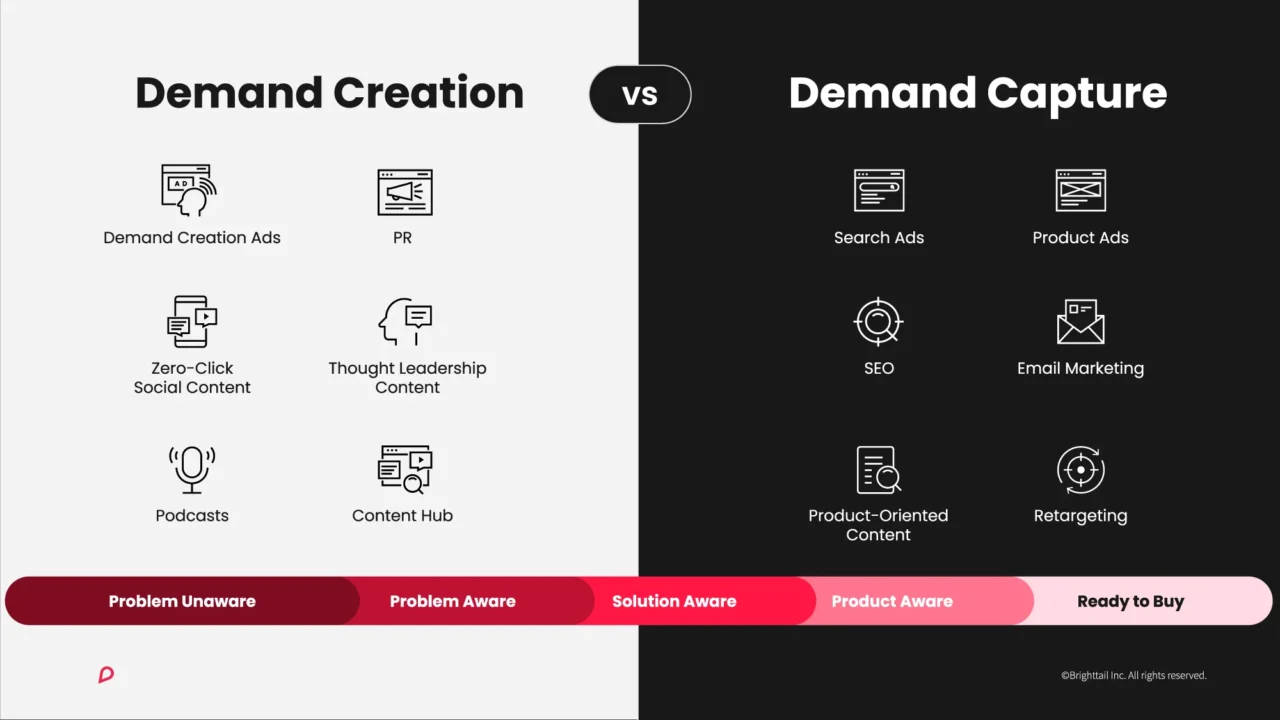
Creating demand for your Atlassian Marketplace app is a crucial go-to-market (GTM) strategy in a competitive landscape.
Research from the Ehrenberg-Bass Institute shows that only 5% of potential buyers are actively in the market, leaving 95% who are unaware or resistant to change. This highlights the importance of distinguishing between demand creation and demand capture.
In this blog post, we will explore six strategies to help you win new audiences and create demand for your Atlassian Marketplace app.
6 Powerful Demand Creation Tactics
Demand creation aims to raise awareness of a problem and create urgency for a new solution among those who don’t yet recognize their need for your app. This strategy is crucial for Atlassian app vendors to tap into the larger, inactive market segment.

By implementing effective demand creation tactics, you can expand your reach and build sustained interest in your app. Below are six demand creation tactics that you can use:
#1 Demand Creation Ads
Demand creation ads are designed to introduce your app to potential users who may not yet be aware of it. These ads aim to build awareness and interest before users actively start searching for solutions.
For example, New Relic’s Pain Point campaign highlighted common pain point users faced (e.g., cause or website crashes, memory leak) and presented New Relic as the solution, effectively creating demand by addressing those issues.

Best Practices
- Use demographic and interest-based targeting to reach a wide audience.
- Incorporate eye-catching images or videos that highlight your app’s benefits.
- Ensure your ad copy clearly communicates the value proposition of your app.
- Use limited-time offers or scarcity tactics to create a sense of urgency and encourage potential customers to take action.
#2 Public Relations (PR)
Public Relations (PR) helps build your app’s credibility and visibility through media coverage and influencer endorsements.
We can use Atlassian’s “Cash for Clunkers” campaign as an example. This PR campaign generated significant buzz and demand by offering incentives for users to switch from competitors’ apps.

Different Types of PR Strategies to Use
- Press Releases: Announce new features, updates, or significant milestones. Here’s an example of a press release by Ricksoft, an Atlassian app vendor.
- Media Outreach: Pitch stories to relevant tech and industry publications such as TechCrunch and HackerNoon.
- Influencer Partnerships: Collaborate with industry influencers to reach a broader audience.
#3 Zero-Click Social Content
Zero-click content is designed to engage users directly on social media platforms without requiring them to click through to another site. This type of content is designed to be consumed entirely within the social media platform, keeping users engaged and reducing friction.
The benefits of zero-click social content are aplenty:
- Improved Algorithm Performance: Social media platforms tend to favor content that keeps users on their platforms, and by creating zero-click content, you’re more likely to be rewarded by the algorithm and have your posts shown to a wider audience.
- Enhanced User Experience: Social media users generally prefer content that can be consumed without leaving the platform they’re on, and zero-click content caters to this preference, providing a seamless and enjoyable experience for your audience.
- Increased Engagement: When users don’t have to click through to another page, they’re more likely to engage with your content by liking, commenting, or sharing it, which can lead to higher reach and better brand awareness.
- Stronger Relationships: By offering valuable, standalone content, you’re demonstrating your expertise and building trust with your audience, which can help you foster stronger relationships with your followers.

Zero Click Social Content Ideas
- Informative Threads: Create multi-tweet threads on Twitter that provide step-by-step instructions for using your Atlassian app, share insights from user data, or tell a compelling story about a common problem your app solves.
- Carousel Posts: Use LinkedIn carousels to present information in a visually engaging way. Each slide can highlight a key feature of your app, a user testimonial, or a piece of valuable content that educates your audience.
- Short-Form Videos: Leverage platforms like LinkedIn and YouTube Shorts to create bite-sized, educational videos. These videos can demonstrate how to use specific features of your app, share quick productivity tips, or showcase success stories from your users. The video below shows Communardo’s LinkedIn post that is a video announcing the latest cloud version of the SubSpace Navigation for Confluence app.
- Data Visualizations: Present data, statistics, or infographics about the benefits and performance improvements users can achieve with your Atlassian app. Make these visuals engaging and easy to consume directly within the social feed.
- Polls and Surveys: Engage your audience by asking thought-provoking questions or gathering their opinions through interactive poll features on platforms like Twitter and LinkedIn. Use the feedback to generate discussions and insights related to your app’s use cases.
#4 Thought Leadership Content
Thought leadership content establishes your brand as an authority in your industry, building trust and interest among potential users.
Some examples of thought leadership content you can use are blog posts, white papers, and industry reports. For example, one of our successful Atlassian campaigns is for Communardo – The Hitchhiker’s Guide to the Atlassian App-Galaxy. The guide is a compilation of case studies from many Atlassian app vendors.
This thought leadership content resulted in Communardo having stronger customer partnership and brand visibility within the Atlassian ecosystem. They also experienced a 3x increase in event leads at the Atlassian Summit and extensive online engagement due to successful co-marketing with featured vendors.
#5 Podcasts
Podcasts are growing in popularity and offer a unique way to engage with your audience through in-depth discussions and storytelling.
To start a podcast, you should discuss relevant issues, trends, and insights related to your app. And then feature industry experts and influencers to provide valuable perspectives.
You can also appear as a guest on other relevant podcasts to reach new audiences and use these opportunities to subtly promote your app and its benefits.
Here’s a list of active podcasts by other Atlassian Partners. You can consider reaching out to them for collaboration opportunities.
- The Atlassian Ecosystem (from Adaptavist)
- Atlassian Advantage (from Carahsoft)
- Kickass Software, Rock ‘n’ Roll Teams (from SeibertMedia)
- DevOps Sauna (from Eficode)
- The Jira Life (by Rodney Nissen & Alex Ortiz)
- Por las nubes de Atlassian (from DEISER)
- Orquestrando Herramientas Atlassian (from Elite IT Consulting Group)
- Atlassian Impact with Isos Technology (from Isos Technology)
- Nos vemos en la nube (from Itera Process)
- Conversations with Chief Innovators (from Modus Create)
#6 Content Hub
A content hub is a centralized repository of valuable information related to your app and industry.
A successful content hub should feature a variety of content formats, including blog posts, solution pages, case studies, videos, podcasts. Organize by topic to make it easy for users to find content relevant to their interests. For example, Elements’ content hub is categorized into various formats like video and webinar and related topics like ITSM and Jira.

Ways to Promote Content Hub
- SEO: Optimize your content hub for search engines to attract organic traffic.
- Social Media Promotion: Regularly share content from your hub on social media to drive traffic.
- Email Marketing: Include links to your content hub in your email newsletters.
By using these demand creation tactics, Atlassian Marketplace app vendors can effectively generate interest, engage new audiences, and ultimately drive business growth.

Create Demand for Your Atlassian App Today
Creating demand for your Atlassian Marketplace app is key to reaching new audiences and driving growth.
By using effective demand creation tactics, you can engage a wider market and build lasting interest in your app.
To further enhance your marketing efforts, check out our Atlassian Marketplace Marketing service for expert guidance and support.


